By Plan B Writer’s Alliance – http://www.LocustsOnTheHorizon.com
(This article is adapted from the book ‘Locusts on the Horizon‘ from the chapter titled ‘Homemade Reloading Kits’. Step by Step instructional photos at the bottom of the article.)
In our 1187 page, 247,000 word book, Locusts on the Horizon, we have a 409 page Defense section where we go into depth about all aspects of firearms, including selection, history, reloading, home powder manufacture, bullet casting, real world terminal ballistics of common calibers, etc. In one of the chapters in that section, ‘Homemade Reloading Kits’, we show you how to make both a 12 gauge and a .410 gauge homemade reloading kit for shotgun shells.
The 12 gauge was an obvious choice because it is the most popular centerfire cartridge in North America, but why the .410?
The .410 is a favorite amongst homesteader types and others. Like the .22LR, the .410 is ‘just enough’ in skilled hands to do a wide variety of tasks. Unlike the .22LR, it’s reloadable and in experienced hands is reliably good against birds in flight as well as ground targets. It’s also extremely stingy on powder usage, with typically between 540 and 580 reloads per pound of powder. It’s low recoil also makes it handy for smaller people and youths. Even for those with a minimalist battery, having an inexpensive, single shot .410 around for both general foraging and bringing people’s skills with a shotgun up to speed makes a lot of sense for long term sustainability.
Shotgun ammunition is the easiest of all of the different types of modern centerfire ammunition to reload using homemade and scavenged tools. In this article we will show you a homemade .410 reloading kit. This kit uses the standard fold crimp that modern, plastic shotgun shells typically come from the factory with. This kit will also resize the metallic shell bases on plastic shotgun shells like a regular reloading press will. This kit will work on either 2-3/4” or 3” long .410 gauge shotgun shells.
This method of shotgun ammo reloading is very similar to how shotgun shells were loaded 100 years ago, with the exception of plastic shells and a more modern fold crimp. Our fold crimp reuses the original factory fold crimp in a manner similar to the small ‘Lee Loader’ kits which Lee Precision made for shotgun ammunition years ago, but no longer manufactures. The old, no longer produced Lee Loader kits for shotguns are now in such demand that as of early 2013, if you can find one on eBay, they are being scalped for sometimes $100 or more.
The Lee Loader kits and the other old style of shotgun reloading tools are not that complicated. By replicating these tools using materials and components which are currently and commonly available, people can create for themselves a method to reload shotgun ammunition that is very compact and fairly inexpensive.
While not a substitute for a full size factory made reloading press, especially if you will do reloading in large volume, these can allow you to reload ammo in situations where you cannot obtain a factory made reloading press.
Our homemade .410 shotgun shell reloading kit uses small parts and tools we bought at the hardware store, bought online, and some we found already on hand. This .410 gauge reloading kit can generally be put together for about $20 – $25, or less, depending upon what you already have laying around the house.
DISCLAIMER: This kit we made for ourselves and are showing for educational purposes only. Attempt this at your own risk and your own responsibility. For a project like this always use common sense, don’t smoke or be near open flame while doing this, always wear eye protection, and always use caution at every step. Do not do any project like this near your children or anyone without eye protection.
Always consult a reloading manual for proper load data. Use a precise reloading scale or measured scoops for measuring out the proper amount of powder and shot.
NOTE: Empty shotgun shells are properly called ‘hulls’, but we often use the term ‘case’ here interchangeably for clarity’s sake for most shooters.
THE .410 RELOADING KIT – COMPONENTS & USE
.410 Reloading Kit Components
The .410 kit pictured in the photo has the following numbered components. The components bought online have an * before them. The rest of the components were either found already on hand or bought over the counter from the local ACE Hardware.
1) PVC water pipe, 1/2” diameter, 3-1/2” long, beveled internally at the ends.
2) Galvanized pipe nipple, 5/8” interior diameter
3) Wooden dowel rod, 1/2” diameter
4) Wooden dowel rod, 1/4” diameter
5) 3/8” drive socket, old cheap one made in Taiwan
6) * 410 bore Resize Ring from a MEC 600 reloading press. MEC Part#: 8465410
7) Magnetic bit holder for an electric drill, 3/8” diameter, two of them attached together.
8) * Lee +374 De-capper, from a .45-70 Lee Loader kit. The 3/8” Drywall Anchor Tool we found at ACE Hardware can substitute.
9) * 410 bore ‘Spindex Star Crimp’ – 6 point, from a MEC 600 reloading press. MEC Part#: 8439410
10) Funnel, any funnel will work so long as the tip will fit inside the mouth of the .410 shell case.
11) Scavenged wood and a piece of scavenged steel, something hard to hammer on and protect the table.
12) Hammer, plastic tipped
This .410 gauge reloading kit has the ability to resize the steel base and do a six fold crimp. The Spindex Star Crimp component from a MEC 600 reloading press serve the same exact purpose that the handheld ‘starting crimp’ tool did in the old Lee Loader kits, and is, in fact, almost identical to it in function and size. There is only one style of Spindex Star Crimp made by MEC for the .410, a 6 point, but pretty much every .410 round with a factory fold crimp uses a 6 point fold crimp.
For the .410 kit, we dispensed with the wad guide as it didn’t help like it did in the 12 gauge kit, and was in fact a hindrance, oddly enough. The only wad guides available for the .410 were MEC and they don’t fit the end of plastic pipe or copper tubing as well as those from Lee, which is what we used in the 12 gauge homemade reloading kit with it’s copper loading tube.
We’ve also dispensed with using a loading tube for the .410, and we put the funnel directly into the mouth of the shell case. The PVC tube is simply for holding the loaded shell during the final fold crimp to prevent deformation of the plastic body of the shotgun shell hull during the fold crimping process.
We found a 3/8” Drywall Anchor Tool at ACE Hardware, similar to the 5/8” one we used as a de-capping rod in the 12 gauge kit, and it was small enough to use in a .410 shell case. It was built like it was specifically made to be a .410 de-capping tool. However, the .45 caliber de-capping rod from a Lee Loader kit was already ordered and it works like a champ. Like with the 12 gauge kit, the old, spare socket is the de-capping base. A large nail will also work as a de-capping rod, but the .45 caliber de-capping tool and the drywall anchor tool essentially self-align themselves in the empty .410 shell case and they work well with the resizing procedure whereas a nail will not.
The ‘Galvanized pipe nipple, 5/8” interior diameter’ is for use with the resizing die. After the .410 hull is de-primed, but before is is re-primed with a fresh primer, you place the resizing die over the end of the pipe nipple, and with the plastic tipped mallet you gently whack the .410 hull into the hole in the die. You then flip the die with the hull in it over, put the de-capping rod into the hull, and gently whack the hull out of the die. The metal base of the hull is now resized. Shotgun shell hull bases are steel. Even when the bases if a hull look like brass, they are still steel, just plated
Like all shotgun shells, the .410 has the tip of the seated primer protruding into the case body, above the floor of the interior of the shell case. This means that like other shotgun shells it needs a hollow priming rod that is still strong enough to take multiple hits from a plastic tipped mallet. Due to the smaller diameter of the .410 shell case we could not use the shaft from the multi-tip screwdriver. What we found that did work well was a pair of magnetic bit holders for an electric drill. We used two so they would be long enough, and their magnets held them together.
The scavenged wood and scavenged piece of flat steel are the same as used in the 12 gauge kit and they serve the same purpose. Bothe of the kits we made store in the same small box.
The smaller diameter, ¼” section of wooden dowel has one end slightly beveled to ease insertion into the shell and the wad. This tool is mainly used to insert the plastic wad and push it firmly into place.
The 1/2” diameter wooden dowel rod has been shaped at each end to be the tool which establishes the final fold crimp in two stages. One end of the rod is shaped like a bowl for the first stage of the final crimp, the other is flat with beveled edges for the second stage of the final crimp.
After the Spindex Star Crimp tool is used to start the crimp, the shell is placed into the tube to prevent deformation. The tube is slightly beveled on the inside at the end where the shell inserts. This is to make extraction of the loaded and freshly crimped shell from the tube much easier.
After the shell is inserted into the tube, the bowel end of the rod is used to pinch the crimp further closed, and then the flat end with beveled edges is used to push the pinched fold crimp into place. Do not hammer this. Just a simple push of hand pressure will work. After all, it’s just plastic you are pushing on.
This kit is designed so that the only hammering is done during the de-capping, resizing, and re-priming operations. No hammering is done on a live, loaded shell. The scavenged piece of flat steel is only for placing the primer on for re-priming. The flat metal should not be used for anything else. Use the wood, or a piece of cloth over the wood, for setting the base of the primed shell on during the rest of the reloading process. Make sure no spilled shot is left sitting on the wood. You don’t want anything small and hard under a live primer.
If, somehow, you get any slight mushrooming at the crimp end of the shell, the loaded shell can be rolled into proper shape against the edge of a hard surface, like a table top, sort of how they do when they make a cigar.
At the factory, they often make sure their fold crimps don’t come undone by roll crimping the loaded shell after fold crimping. If you have a roll crimping tool, that can come in handy for this. However, that is usually a bit of overkill for the home reloader.
Here are photos of the stages of reloading a .410 shell with the kit we put together.
© Plan B Writer’s Alliance – Permission to copy and reprint this article is given so long as reference to the original author and the website http://www.locustsonthehorizon.com are mentioned.

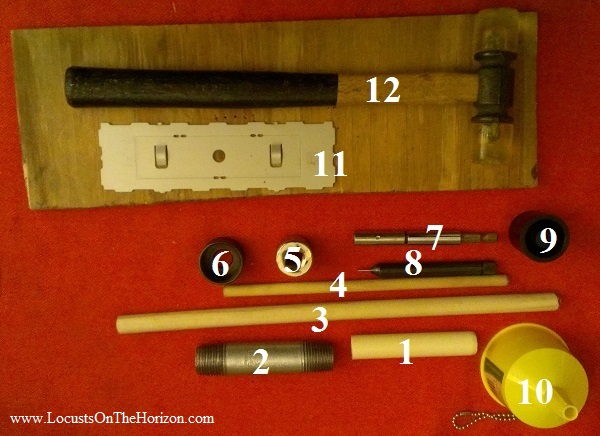

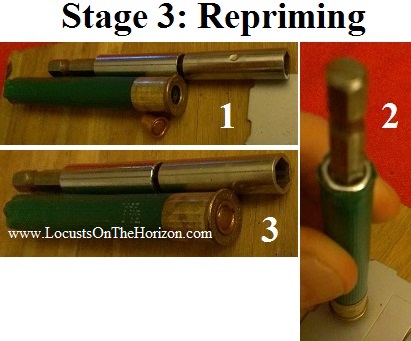
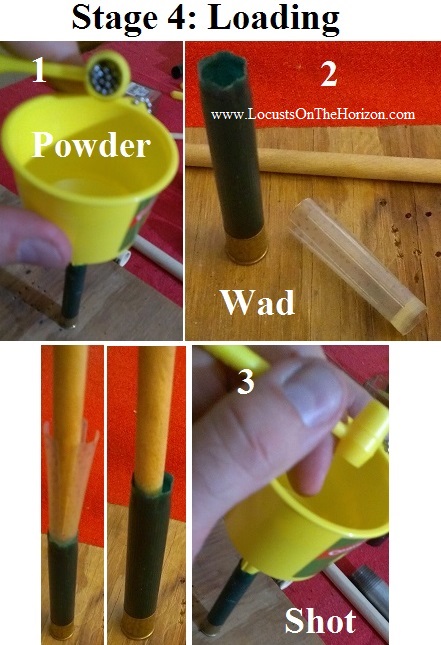
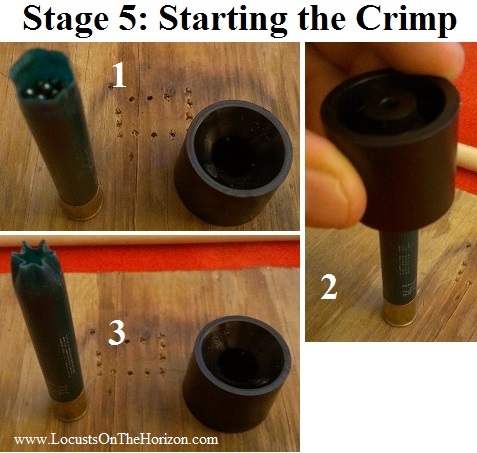
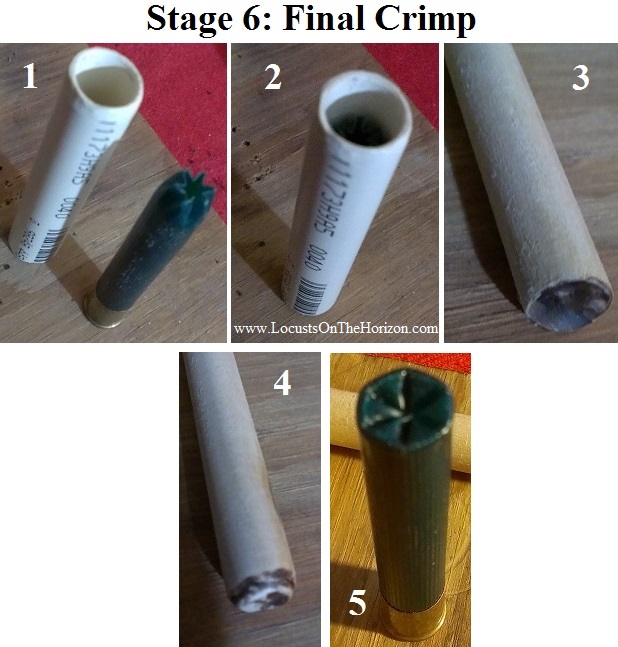
Lee still sells the reloader in 12, 16, and 20 gauge.
http://www.cabelas.com/product/Lee-Load-All-Reloader/741150.uts
Thanks for the reply. That link you gave is for a Lee Load-All. That is an easy to use, full size reloading press for shotgun shells, and one we do recommend for value vs. performance. However, what we talked about in the article was the Lee Loader, which is a small, compact reloading kit which uses a mallet.
Lee Precision still makes the “Lee Loader” for many rifle and pistol calibers, but not for shotgun shells, though they once did many years ago.
Here is a photo of a Lee Loader for a pistol caliber
